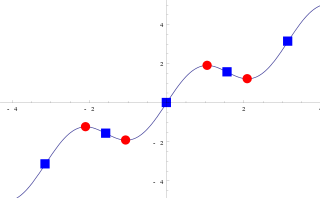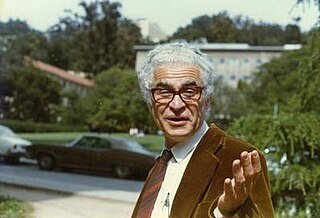In mathematics, a Jacobian, named for Carl Gustav Jacob Jacobi, may refer to:
In mathematics, a Jacobian, named for Carl Gustav Jacob Jacobi, may refer to:
A Jacobite is a follower of someone named Jacob or James, from the Latin Jācōbus. Jacobite or Jacobitism may refer to:
In vector calculus, the Jacobian matrix of a vector-valued function of several variables is the matrix of all its first-order partial derivatives. When this matrix is square, that is, when the function takes the same number of variables as input as the number of vector components of its output, its determinant is referred to as the Jacobian determinant. Both the matrix and the determinant are often referred to simply as the Jacobian in literature.

In mathematics, particularly in algebraic geometry, complex analysis and algebraic number theory, an abelian variety is a projective algebraic variety that is also an algebraic group, i.e., has a group law that can be defined by regular functions. Abelian varieties are at the same time among the most studied objects in algebraic geometry and indispensable tools for much research on other topics in algebraic geometry and number theory.
In mathematics and physics, a tensor field assigns a tensor to each point of a mathematical space. Tensor fields are used in differential geometry, algebraic geometry, general relativity, in the analysis of stress and strain in materials, and in numerous applications in the physical sciences. As a tensor is a generalization of a scalar and a vector, a tensor field is a generalization of a scalar field or vector field that assigns, respectively, a scalar or vector to each point of space. If a tensor A is defined on a vector fields set X(M) over a module M, we call A a tensor field on M.
In mathematics, the Jacobian varietyJ(C) of a non-singular algebraic curve C of genus g is the moduli space of degree 0 line bundles. It is the connected component of the identity in the Picard group of C, hence an abelian variety.

In computer animation and robotics, inverse kinematics is the mathematical process of calculating the variable joint parameters needed to place the end of a kinematic chain, such as a robot manipulator or animation character's skeleton, in a given position and orientation relative to the start of the chain. Given joint parameters, the position and orientation of the chain's end, e.g. the hand of the character or robot, can typically be calculated directly using multiple applications of trigonometric formulas, a process known as forward kinematics. However, the reverse operation is, in general, much more challenging.
Jacobean may refer to:

In algebraic geometry, a Kummer quartic surface, first studied by Ernst Kummer (1864), is an irreducible nodal surface of degree 4 in with the maximal possible number of 16 double points. Any such surface is the Kummer variety of the Jacobian variety of a smooth hyperelliptic curve of genus 2; i.e. a quotient of the Jacobian by the Kummer involution x ↦ −x. The Kummer involution has 16 fixed points: the 16 2-torsion point of the Jacobian, and they are the 16 singular points of the quartic surface. Resolving the 16 double points of the quotient of a torus by the Kummer involution gives a K3 surface with 16 disjoint rational curves; these K3 surfaces are also sometimes called Kummer surfaces.
In mathematics, the Jacobian conjecture is a famous unsolved problem concerning polynomials in several variables. It states that if a polynomial function from an n-dimensional space to itself has Jacobian determinant which is a non-zero constant, then the function has a polynomial inverse. It was first conjectured in 1939 by Ott-Heinrich Keller, and widely publicized by Shreeram Abhyankar, as an example of a difficult question in algebraic geometry that can be understood using little beyond a knowledge of calculus.
Jacobi matrix may refer to:

In mathematics, a critical point is the argument of a function where the function derivative is zero . The value of the function at a critical point is a critical value.
Jacob is an important figure in Abrahamic religions.
In mathematics, the Torelli theorem, named after Ruggiero Torelli, is a classical result of algebraic geometry over the complex number field, stating that a non-singular projective algebraic curve (compact Riemann surface) C is determined by its Jacobian variety J(C), when the latter is given in the form of a principally polarized abelian variety. In other words, the complex torus J(C), with certain 'markings', is enough to recover C. The same statement holds over any algebraically closed field. From more precise information on the constructed isomorphism of the curves it follows that if the canonically principally polarized Jacobian varieties of curves of genus are k-isomorphic for k any perfect field, so are the curves.
In algebraic geometry a generalized Jacobian is a commutative algebraic group associated to a curve with a divisor, generalizing the Jacobian variety of a complete curve. They were introduced by Maxwell Rosenlicht in 1954, and can be used to study ramified coverings of a curve, with abelian Galois group. Generalized Jacobians of a curve are extensions of the Jacobian of the curve by a commutative affine algebraic group, giving nontrivial examples of Chevalley's structure theorem.
In mathematics, the Prym variety construction is a method in algebraic geometry of making an abelian variety from a morphism of algebraic curves. In its original form, it was applied to an unramified double covering of a Riemann surface, and was used by F. Schottky and H. W. E. Jung in relation with the Schottky problem, as it is now called, of characterising Jacobian varieties among abelian varieties. It is said to have appeared first in the late work of Riemann, and was extensively studied by Wirtinger in 1895, including degenerate cases.
In mathematics, the Schottky problem, named after Friedrich Schottky, is a classical question of algebraic geometry, asking for a characterisation of Jacobian varieties amongst abelian varieties.
There are several conjectures in mathematics by David Mumford.

Maxwell Alexander Rosenlicht was an American mathematician known for works in algebraic geometry, algebraic groups, and differential algebra.
George Rushing Kempf was a mathematician who worked on algebraic geometry, who proved the Riemann–Kempf singularity theorem, the Kempf–Ness theorem, the Kempf vanishing theorem, and who introduced Kempf varieties.
OJA may refer to: